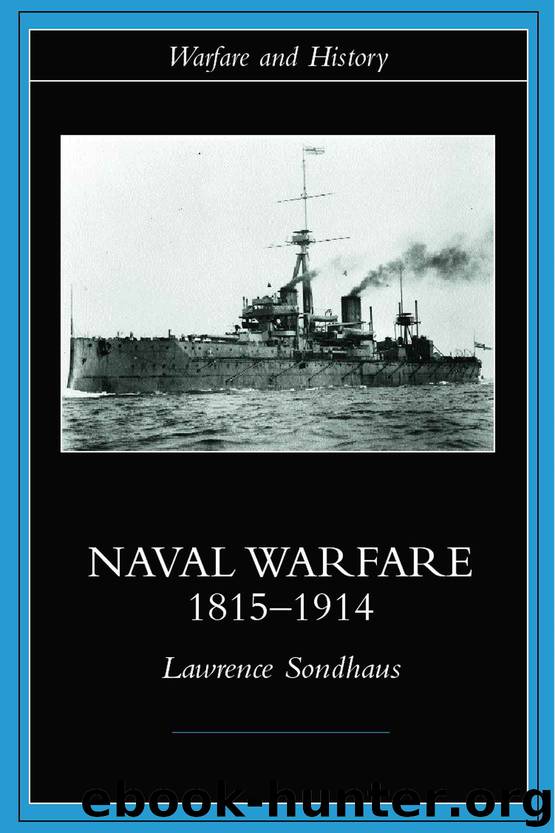Naval Warfare, 1815-1914 (Warfare and History) by Lawrence Sondhaus

Author:Lawrence Sondhaus [Sondhaus, Lawrence]
Language: eng
Format: epub
ISBN: 9780203132234
Publisher: Taylor and Francis
Published: 2012-10-12T00:00:00+00:00
Japan and China
Thus the Arturo Prat, commissioned in 1885 with the name Tsukushi, became the first steel cruiser in the Japanese navy. By that time, thanks to steps taken during the 1870s, the foundations of Japan’s future naval power had been established. At the end of the civil war of 1868–69 the imperial fleet included the armored ram Adzuma (ex-Kotetsu), the armored corvette Ryujo, and six wooden steamers of various types. In the early 1870s the navy added three screw corvettes purchased from Britain, France, and the Netherlands, and a composite gunboat from Britain. Like its German counterpart of the same decade, the Japanese navy had non-seamen among its leaders, and lacked both a maritime tradition of its own and the infrastructure to support a modern fleet. A British naval mission (1873–79) imported British-style traditions and practices for officers and seamen alike, and established a curriculum for the naval academy in Tokyo.
The navy’s next action came in 1874, against Taiwanese pirates. Problems encountered during that operation, coinciding with worsening relations with Korea, sparked a naval build-up during the second half of the decade. The 3,720-ton casemate ship Fuso, the 2,200-ton armored corvettes Hiei and Kongo, and four torpedo boats were ordered from British shipyards, while French advisors arrived to supervise the construction of four wooden screw steamers in the Yokosuka shipyard.69 By the end of the decade Japan had five armored warships, supplemented by an unarmored fleet of five frigates or corvettes (over 1,000 tons) with two more under construction, and seven sloops or gunboats (under 1,000 tons), but until the arrival of the Tsukushi (ex-Arturo Prat) in 1885, the casemate ship Fuso was the only formidable fighting vessel. stage until it had surpassed Peru, Japan at this time still measured its naval power
Just as Chile could not aspire to be a second-rate naval power on the world against that of its regional rival, China. Unlike Japan after the Meiji Restoration, China never took decisive measures to save itself from Western domination. Nevertheless, during the 1860s China ordered four screw gunboats in Britain and built a screw corvette and two screw gunboats at Foochow. Between 1870 and 1876 the Foochow yard built another eight screw corvettes and three gunboats, all wooden ships, followed between 1877 and 1880 by four composite corvettes. Meanwhile, between 1872 and 1876 the Kiangyan shipyard built two wooden screw frigates and a composite gunboat. China’s first armored warships were flatiron gunboats built for coastal and river service. Between 1875 and 1880 British shipyards launched fourteen such vessels for the Chinese navy, displacing between 260 and 440 tons, only four of which had significant armor plating. The 200-ton flush-decked Tiong Sing, launched in 1875 at Shanghai, was the only Chinese ironclad built in China.70
Thus, by the end of the 1870s China had fifteen armored warships but the largest was less than one-third the size of the smallest of Japan’s five ironclads. Whereas none of the Chinese ironclads could operate out of sight of the coast, all of Japan’s ironclads, at least theoretically, were high seas warships.
Download
This site does not store any files on its server. We only index and link to content provided by other sites. Please contact the content providers to delete copyright contents if any and email us, we'll remove relevant links or contents immediately.
| Africa | Americas |
| Arctic & Antarctica | Asia |
| Australia & Oceania | Europe |
| Middle East | Russia |
| United States | World |
| Ancient Civilizations | Military |
| Historical Study & Educational Resources |
1805 by Richard Woodman(851)
Labyrinth of Ice by Buddy Levy(649)
RMS Titanic by Peter Davies-Garner(611)
A Game of Birds and Wolves by Simon Parkin(525)
1812: The Navy's War by George C. Daughan(515)
Life by Tim Flannery(510)
Rogue Warrior by Richard Marcinko(508)
Sontag, Sherry - Blind Man's Bluff by Sontag Sherry(443)
Naval Warfare, 1815-1914 (Warfare and History) by Lawrence Sondhaus(441)
The Rise And Fall of British Naval Mastery by Paul Kennedy(437)
Tracing Your Merchant Navy Ancestors by Simon Wills(419)
American Naval History by Craig L. Symonds(417)
Warship 2019 by John Jordan(415)
The Supercarriers: The Forrestal and Kitty Hawk Classes by Andrew Faltum(398)
Roosevelt's Navy by James Tertius De Kay(375)
The Imperial Cruise by James Bradley(367)
The Imperial Cruise: A Secret History of Empire and War by James Bradley(364)
Men-of-War by Patrick O'Brian(364)
Modern Military Strategy by Elinor C Sloan(350)
